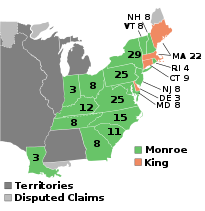
Back انتخابات الرئاسة الأمريكية 1816 Arabic ھەڵبژاردنی سەرۆکایەتیی ویلایەتە یەکگرتووەکانی ئەمریکا (١٨١٦) CKB Volby prezidenta USA 1816 Czech Præsidentvalget i USA 1816 Danish Präsidentschaftswahl in den Vereinigten Staaten 1816 German Elecciones presidenciales de Estados Unidos de 1816 Spanish انتخابات ریاستجمهوری ایالات متحده آمریکا (۱۸۱۶) Persian Yhdysvaltain presidentinvaalit 1816 Finnish Élection présidentielle américaine de 1816 French הבחירות לנשיאות ארצות הברית 1816 HE
| |||||||||||||||||||||||||||||
217 members of the Electoral College 109 electoral votes needed to win | |||||||||||||||||||||||||||||
|---|---|---|---|---|---|---|---|---|---|---|---|---|---|---|---|---|---|---|---|---|---|---|---|---|---|---|---|---|---|
| Turnout | 16.9%[1] | ||||||||||||||||||||||||||||
| |||||||||||||||||||||||||||||
 Presidential election results map. Green denotes states won by Monroe and Light Orange denotes states won by King. Numbers indicate the number of electoral votes cast by each state. | |||||||||||||||||||||||||||||
| |||||||||||||||||||||||||||||
Presidential elections were held in the United States from November 1 to December 4, 1816. In the first election following the end of the War of 1812, Democratic-Republican candidate James Monroe defeated Federalist Rufus King. The election was the last in which the Federalist Party fielded a presidential candidate.
As President James Madison chose to retire after serving two terms, the Democratic-Republicans held a congressional nominating caucus in March 1816. With the support of Madison and former President Thomas Jefferson, Secretary of State Monroe defeated Secretary of War William H. Crawford to win his party's presidential nomination. Governor Daniel D. Tompkins of New York won the Democratic-Republican vice presidential nomination, continuing the party's tradition of balancing a presidential nominee from Virginia with a vice presidential nominee from either New York or New England. The Federalists did not formally nominate a ticket, but Senator King of New York emerged as the de facto Federalist candidate.
The previous four years of American politics were dominated by the effects of the War of 1812. Its drawn outcome and the peace concluded in 1815 were satisfactory to the American people, and the Democratic-Republicans received credit for the results. Federalists were discredited by having opposed the war and by radical rhetoric from New England Federalists at the Hartford Convention. Also, President Madison had adopted certain measures favored by Federalists, including a national bank and protective tariffs. The Federalists had little to campaign on, and Monroe easily won the Electoral College, carrying 16 of the 19 states.
- ^ "National General Election VEP Turnout Rates, 1789-Present". United States Election Project. CQ Press.

